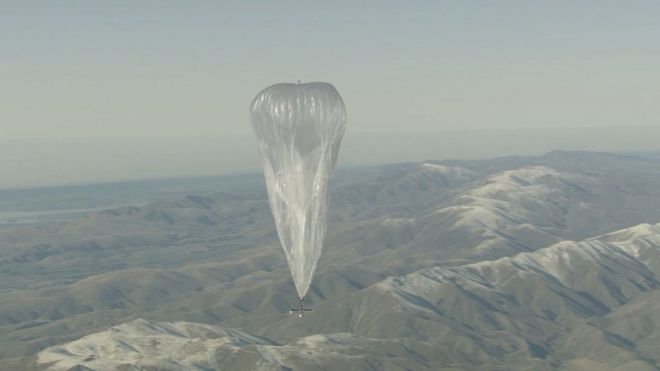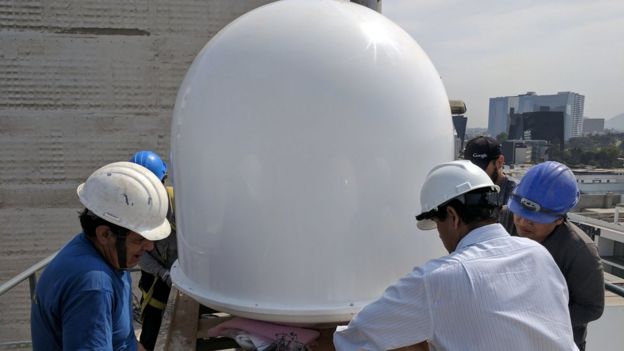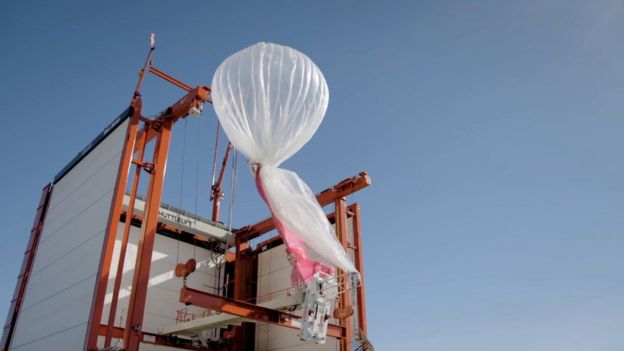Google's balloons connect flood-hit Peru
- Get link
- X
- Other Apps

Project Loon uses tennis court-sized balloons carrying a small box of equipment to beam internet access to a wide area below.
The team told the BBC they had been testing the system in Peru when serious floods hit in January, and so the technology was opened up to people living in three badly-hit cities.
Until now, only small-scale tests of the technology had taken place.
Project Loon is in competition with other attempts to provide internet from the skies, including Facebook’s Aquila project which is being worked on in the UK.
Project Loon recently announced it had figured out how to use artificial intelligence (AI) to “steer” the balloons by raising or lowering them to piggy-back weather streams. It was this discovery that enabled the company to use just a “handful” of balloons to connect people in Lima, Chimbote, and Piura.
The balloons were launched from the US territory of Puerto Rico before being guided south.
Over the course of three months - at the time of writing the balloons were still providing access - users have sent and received 160GB-worth of data, the equivalent of around 30 million instant messages, or two million emails.

“So the thing about stratosphere balloons is they’re 20km above us, and they’re way above a lot of the chaos that goes on down on the ground,” Sal Candido, a Project Loon engineer, told the BBC.
The connectivity has covered an area of 40,000 square kilometres, roughly the size of Switzerland.
The floods left 94 people dead and 700,000 more homeless.
A balloon-connected future
The connectivity was enabled with the help of Spanish telecoms giant Telefonica, which operates in Peru, and several other organisations who aided in setting up ground stations that enabled the balloons to connect to the internet.
“The company focused on bringing the best connectivity support in these emergency situations, especially in the most affected areas," said Telefonica's Dennis Fernandez.
"It was a complex logistical challenge to attend all the needs in those extreme circumstances”.

Users of the service would experience much the same service as if they were using Telefonica as normal - except the signal was being provided via the balloons rather than traditional masts.
"Our tests in previous months focused on integrating our technology into Telefonica’s network to connect people, but we’d never done a wide scale trial directly to people’s phones,” said Alastair Westgarth, who leads Project Loon.
The technology is still in its early stages, and while Project Loon was able to roll out quickly in Peru, that is due to the company already having set up in the area for technical trials planned before the flooding took place.
The concept - whether balloons or drones - still faces a number of challenges, most related to keeping the equipment in the air. Both Project Loon and Facebook’s Aquila have seen their technology crash land.
When working, the record length of time for a Project Loon balloon is 190 days. Facebook recently said it had completed an Aquila flight that lasted 96 minutes.
Others question the motive of Silicon Valley companies expanding into the developing world with such vigour - particularly over how both Facebook and Project Loon may be able to collect data that could later be used to sell targeted advertising.
Mr Candido said as Project Loon was being used to serve Telefonica’s network, no data was being collected by Project Loon during the experiment in Peru.
- Get link
- X
- Other Apps
Popular posts from this blog
What is Muzo?
Using Billion Sound Technology (BST), the Muzo smart acoustic device attaches to any smooth surface and generates dynamic, realistic sounds, while promising to cancel vibration and outside noise. This way, the company claims that Muzo can turn almost anything into a crystal clear acoustic environment, including windows, walls, and desks and other furniture; improve the quality of your sleep, and even help protect your speech privacy. And it promises to do all of this over three steps: Position Muzo toward the noise and reposition if needed. Gently press the large button on the surface to select your ambient noise (or, use the noise-canceling technology by itself). Rotate the button to adjust soundtrack volume. Together, the company tells us that Muzo’s noise-blocking technology can create a “personal zone creator” that can work as an alternative to sleep aids and costly sound machines. Muzo sure sounds cool, but is it worth the money? Is it even a feasible con...
Pup Smart Scanner:
Using a scanner is usually not the most user-friendly experience you'll ever have. Since you'll have to find your scanner, which is probably under about 5 boxes. You then have to connect it to your computer, which the drivers are probably either not installed or out of date. Then you have to put each individual document you want to scan into the device and wait about 2 minutes each. The Pup is a super simple scanner that works just like a camera, and takes just seconds to scan each item you want digitized. How it works is, you select the settings beforehand on how you'd like to scan it, and what you'd like to do with it once it's scanned, then you hold the Pup Smart Scanner above what you'd like to scan, and lasers will square off and show you exactly what you're about to scan. Then just press the button to initiate the scan, and a flash will illuminate the document, and it will scan it within seconds. Perfect for keeping your child's dr...
Comments
Post a Comment